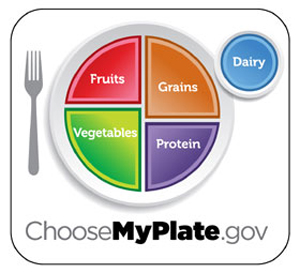By Len Saunders, MA
Children may be away from school and locked into summer mode, but July and August may be a great time to teach them about proper nutrition and healthy lifestyle through the USDA’s MyPlate.
As informative as the old MyPyramid used to be, quite honestly, it made nutrition a task to understand for most children. From their point of view, what does a pyramid have to do with food or nutrition? MyPlate does put it into perspective for kids at a level they can understand. They look at the plate, and see the food groups laid out for them in a form of a pie chart, distributing the percentages of the foods needed daily. For children, sometimes simple and basic is more effective to get a message across to prepare them for a healthy future.
Respected author and creator of the Zone Diet, Dr. Barry Sears agrees. “The earlier dietary habits are instilled in children, the longer they last.”
MyPlate is divided into five sections. Each section (food group) has its own color, with vegetables and fruits consuming one half of the plate, while grains and proteins take up the other half. Dairy is off to the side in the form of a cup.
According to registered dietitian Sharon Palmer, “The beauty of MyPlate is that it offers a very simple, take home message – fill your plate with ¾ plant foods, such as whole grains, fruits, vegetables, and legumes. You can simply pile up one quarter of the plate with a grain, such as brown rice or whole grain pasta, the other quarter of the plate with a lean protein source such as fish, chicken or beans, and the rest should be fruits and veggies.“
Summertime is an excellent opportunity to teach children about healthy eating through MyPlate. Here are some suggestions from registered dietician Ann Dunaway, which can make eating healthy and a lot of fun.
- Print out the MyPlate graphic from their website and keep in a visible spot in the kitchen such as the refrigerator door.
- Find old magazines along with paper plates and let children make an art project cutting out photos of food and gluing on their own plates to mimic MyPlate.
- Serve meals family style with several fruit and vegetable options and let the children put together their own plate following the MyPlate graphic.
- Get children involved with meal preparation. The more involved children are with picking out and preparing foods, particularly fruits and vegetables, the more willing they are to try it.
- Parents should be role models and follow MyPlate as well.
- Have perseverance. Research has shown that it can take 15-20 exposures to a new food before a child likes it, so keep at it and reinforce MyPlate messages and your children will eventually get the message.
When children are exposed to healthy eating at young ages, they will carry this type of lifestyle into adulthood. Remember, children are not mini adults, so their portion size should be suitable for their age and body type. Be sure to empower children into the decision making of their snacks and meals. Giving them some input into healthy choices will positively impact their eating habits through the use of the USDA’s MyPlate.
___________
Len Saunders is the author of Keeping Kids Fit and nationally recognized for his work in the fight against childhood obesity. You can learn more about his work from his website LenSaunders.com.
Also Read:
5 Balanced Dinner Menus to Fill Your MyPlate Icon
The Other Food Pyramid: What Harvard’s Has that MyPlate Doesn’t
Len Saunders’ An Adventure in Exercise
image via eatright.org
